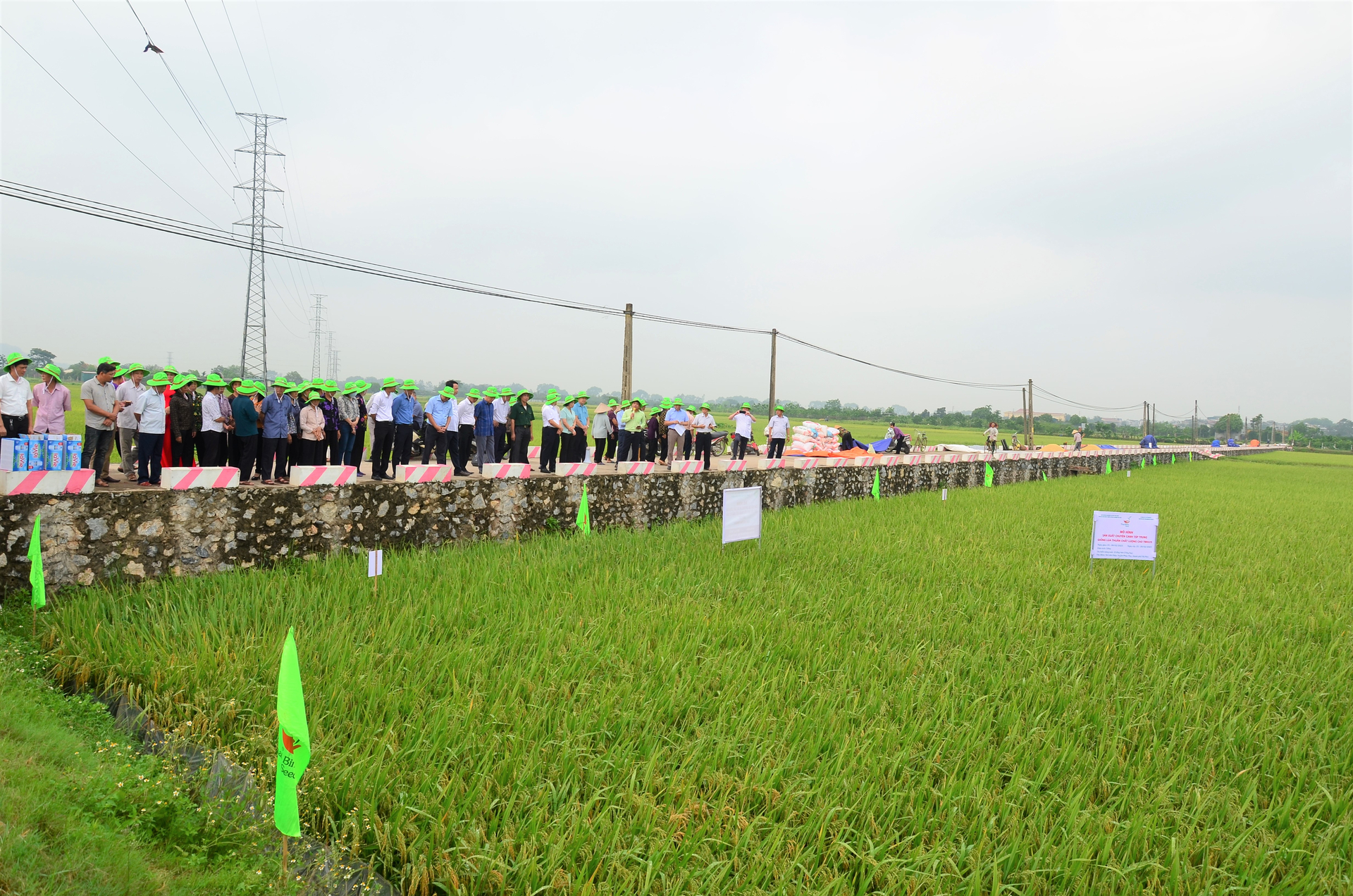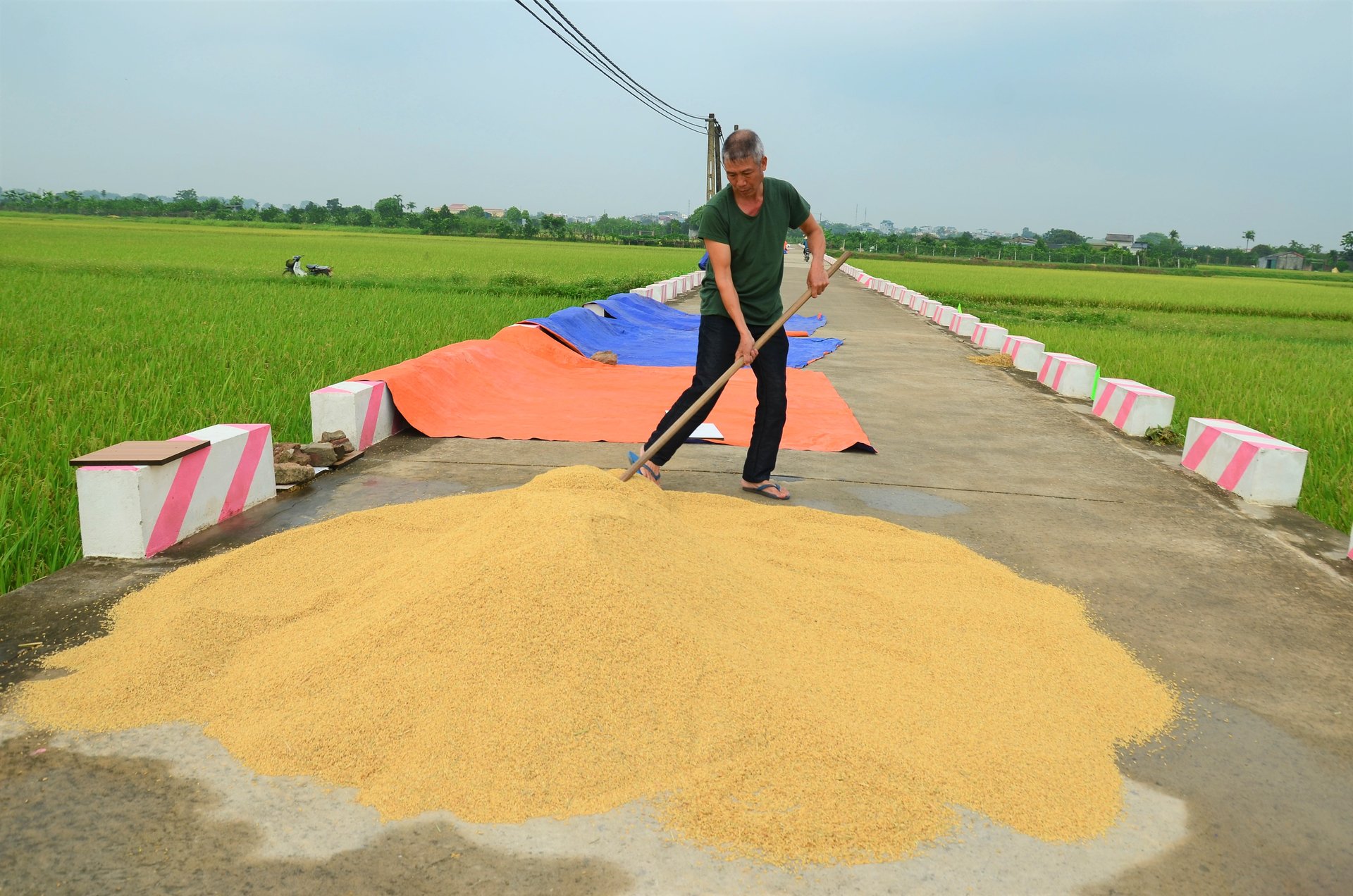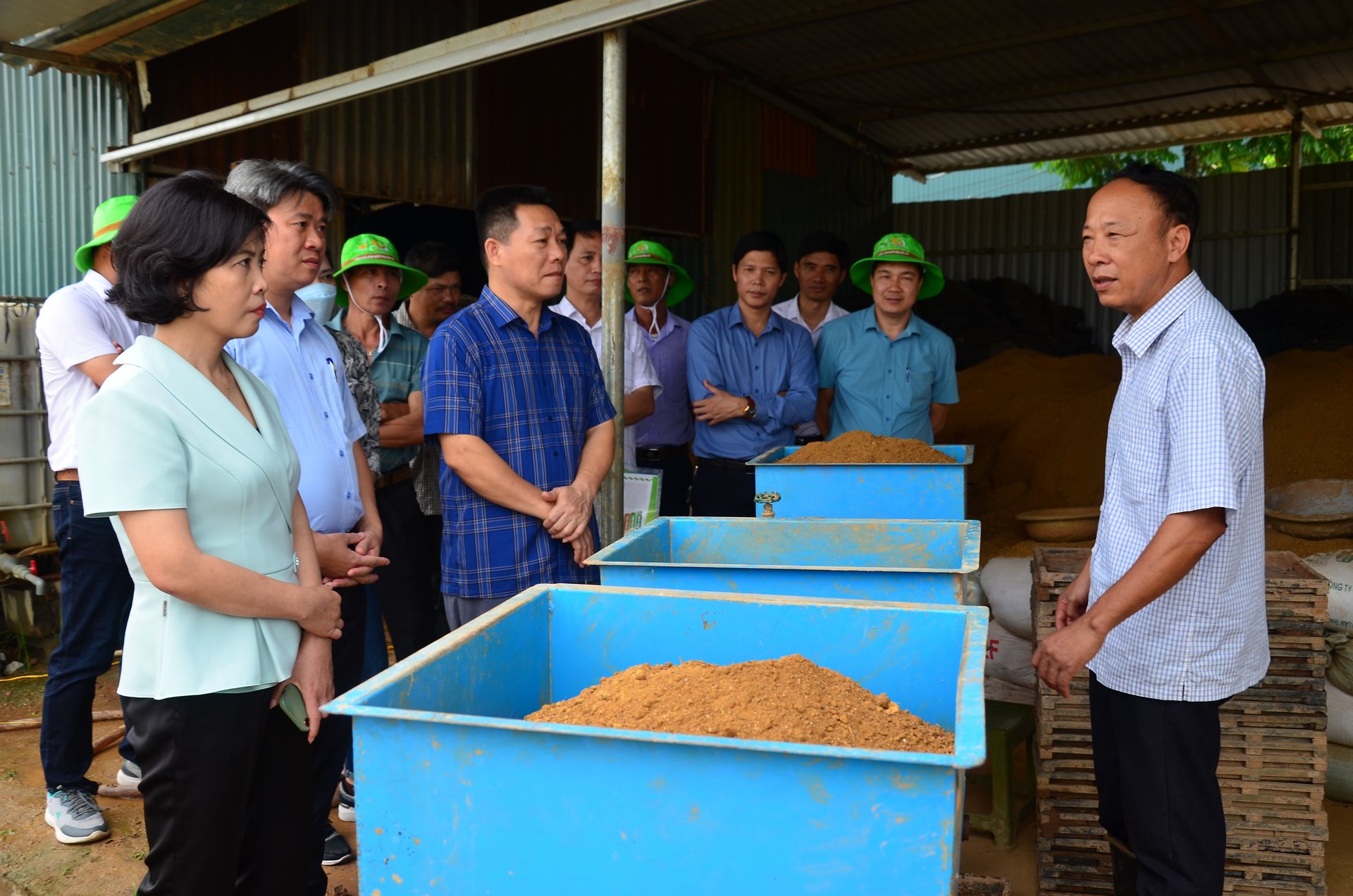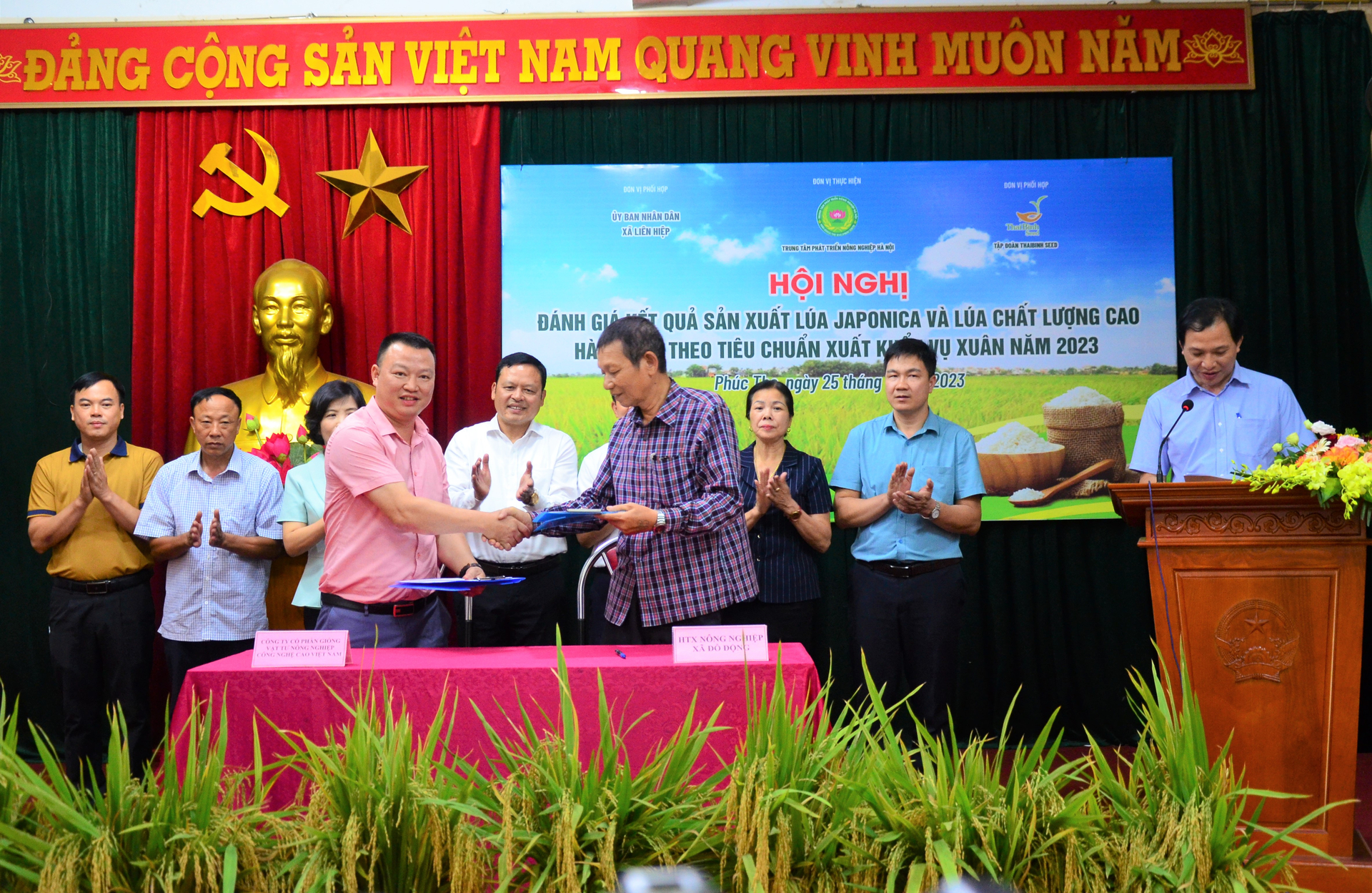High-quality rice dominates
There was a time when farmers in the capital transplanted “rice wine” not only for processing vermicelli and cooking wine, but also for food, because the taste was similar to that of hard rice, although not very rich and delicious. But over time, this habit has completely changed.
The rice cultivation area of Hanoi is about 150,000 ha/year, the production is over 900,000 tons/year, of which more than 60% is the structure of high quality rice varieties. Contributing to this trend is the Hanoi Agricultural Development Center – the unit tasked with implementing the plan to develop japonica rice and high-quality rice in line with the city’s export standards.

Direct Conference in Lien Hiep Township, Phuc Tho District. Picture: Duong Dinh Tuong.
For many years, the spring harvest of 2023 has been considered a rare weather phenomenon, when there are almost no showers and the weather is persistently cloudy, creating favorable conditions for blast diseases, smearing and the outbreak of brown planthoppers. In this unfavorable context, the Hanoi Center for Agricultural Development has instructed its staff to regularly follow the model and examine and monitor the situation of pests and diseases in the field based on the instructions and instructions from the agricultural sector and the results of pest control and On-site disease surveys to issue 8 technical guidelines and inform about the situation of pests and diseases and control measures.
When the pest survey reached the limit, the center organized drone spraying of 520 hectares of rice. The results have resulted in labor cost savings, worker safety, concentrated spraying time and timing, resulting in high prevention efficiency. Local farmers are very excited because they benefit from 50% of the cost of pesticides and do not lose productivity.
In the harvest season, roads in Dong Ngoai, Dong Rieng, Dong Sai, Dong To, Cay Vong, Roc Moi, Uom, Dung, Blue Lagoon, Long of Lien Hiep Township, Phuc Tho District (Hanoi City) fields are flooded with new yellow rice. The farmers talked while plowing the rice. The scraping of the ground on the road mingled with the sound of the harvester rattling like country music in the field when the door was opened.
Mr. Nguyen Viet Huynh, director of Lien Hiep Agricultural Service Cooperative, said that this crop, 498 households participated in the program of high-quality TBR 225 bulk rice, covering a total area of 50 hectares. The participating households are supported with 50% of the costs for seeds, fertilizers and pesticides. Synchronous mechanization was applied in many phases, such as B. Tillage, shell plating – mechanical transplanting, spraying by plane, harvesting by combine.

Drying rice on a dirt road in Lien Hien Township, Phuc Tho District. Picture: Duong Dinh Tuong.
The community has developed a strong handicraft village, so people are very busy, so the cooperative is responsible for six agricultural services, such as: B. Supplying seeds, materials, soil preparation, tray plating – transplanting machine… In addition to providing production to local people. At the table, the cooperative is also expanding its links with other cooperatives. The water regulation in the field follows the improved rice cultivation technique SRI. As a result, the yield of this crop is estimated at 68 quintals/ha, the profitability is 34 million dongs/ha.
Set up a closed chain
Lien Hiep is just one of Hanoi Agricultural Development Center’s 12 production models of japonica rice and high-quality rice in 11 townships in 5 districts of Thanh Oai, Chuong My, Phuc Tho, Soc Son and Me Linh in the spring harvest. 2023 with a total area of 610ha.
Although many varieties of japonica rice (Japanese rice) are grown in Hanoi, the center selects only the J02 variety from Vietnam High-Tech Agricultural Materials and Seeds Joint Stock Company to put into the structure due to yield and quality factors. Quality. Specifically, this crop includes 260ha of J02 rice, 190ha of TBR 225, 150ha of Dai Thom 8 rice and 10ha of HD11 rice. In terms of yield, VietGAP rice cultivation is estimated at 6.5-7 tons/ha, organically grown rice is estimated at 5.5-5.8 tons/ha, total rice production is 4,177 tons.
Most interesting is the profitability, the rice variety J02 takes the top position, after deducting all costs and labor, it averages about 29-30 million VND/ha/crop, higher than “rice wine” Khang Dan with 15 million VND/ha / Harvest. Second, third and fourth are TBR 225, Dai Thom 8, HD11 averaging about 25 million VND/ha/crop, higher than Khang Dan’s “rice wine” at 11-12 million VND/ha/crop.

Lien Hiep Cooperative in Phuc Tho District carries out shell plating and machine transplanting services. Picture: Duong Dinh Tuong.
In addition, the program also has environmental impacts such as: B. raising awareness and responsibility of officials and farmers for the efficiency of land use, as well as reducing the use of chemical fertilizers, chemicals (medicines and pesticides, pests, highly toxic herbicides) in production. Changing some old farming habits to conserve natural enemies, balance the ecosystem, produce sustainably, and help conserve and protect land, water, and environmental resources.
The Hanoi Agricultural Development Center has recognized that product consumption is a key stage for sustainable production development, and from the beginning of harvesting, it has linked companies with product consumption and implemented steering activities. Cooperatives develop rice consumption plans for farmers.
So far, five companies have worked with cooperatives to sell products to farmers, including: Vietnam High-tech Agricultural Materials and Seeds Joint Stock Company, Long Vu Food Co., Ltd., Khang Long Food and Foodstuffs Limited, Dong Son Company, Meine credit company.
Hoang Thi Hoa, director of the Hanoi Agricultural Development Center, said many cooperatives are still afraid because the business value of the rice production chain is very low, and most prefer to sell fresh rice directly in the field for leisure. Currently, the city has Tam Hung Cooperatives in Thanh Oai District and Doan Ket Cooperatives in Ung Hoa District, which operate rice cultivation in a closed chain from production to rice processing, packaging and consumption.
In addition, there are cooperatives that manufacture chains in parts from input services and seeds to fresh rice purchasing organizations for farmers, such as Binh Minh Cooperative, Do Dong Cooperative in Thanh Oai District and Tan Hung Cooperative in District society

Hanoi City and Vietnam High-Tech Agricultural Materials and Seeds Joint Stock Company signed a cooperation agreement on rice consumption. Picture: Duong Dinh Tuong.
“Although many cooperatives have established rice brands, they still fear processing, packaging and consuming in small bags. In the coming period, the center, led by the Ministry of Agriculture and Rural Development of Hanoi, will mobilize cooperatives to build, process, pack and consume brands of rice in small bags to introduce consumers to products that combine both quality and safety offer.
Typically, Lien Hiep Agricultural Cooperative undertakes the services of soil preparation, planter planking, pesticide spraying, harvesting, and planning the development of more land for drying, processing and packaging of rice products with labels. Sufficient to reduce loss rate and improve quality and value.
The center will work with the Economic Department of Phuc Tho District, as well as the Municipal People’s Committee and Lien Hiep Cooperative to jointly implement these contents. The trend of rice development in 2021-2025 is synchronization from production to processing, branding, labeling, advertising to providing direct-to-consumer services. This is the only way to ensure efficiency and sustainability,” affirmed Ms. Hoang Thi Hoa.
The process of implementing the plan to develop japonica rice and high-quality rice in line with Hanoi export standards still has some limitations, such as: the coordination of technical management, maintenance and pest control of some cooperatives has not yet ensured timely notification. Without the participation of the Party Committee and the People’s Committee of the Commune, the work of the Model Steering Committee was not effective in some places. Many co-ops fail to communicate through community speakers about support mechanisms, policies, directives and technical direction announcements.
The work of connecting companies to offload products for farmers in some places has not received much attention. The linking of the stages in the production and consumption chain is still loose. The filing and payment completion of some cooperatives is still confusing and untimely, especially in the first year of participation. These deficiencies need to be investigated and addressed by the city in the near future in order to achieve the goal of reaching over 80% quality rice by 2025.
Through the actual implementation of the city’s plan to develop japonica rice and high-quality rice, the Hanoi Agricultural Development Center suggested that scientists continue to search for solutions on varieties, post-harvest technology and adapting production to climate change to improve economic efficiency .

